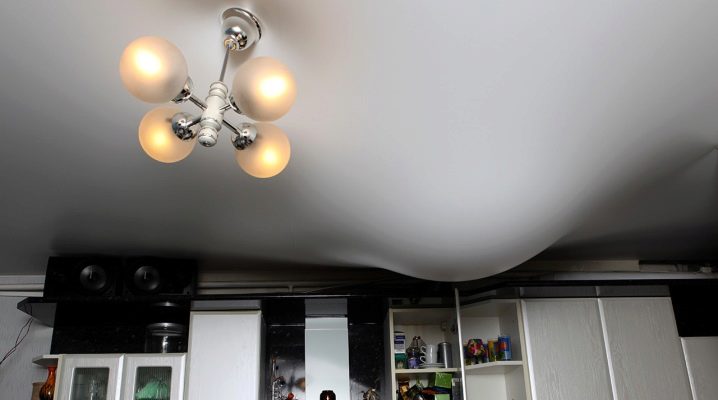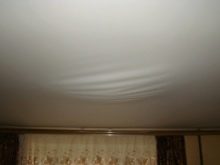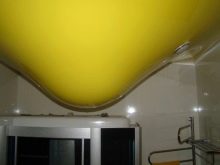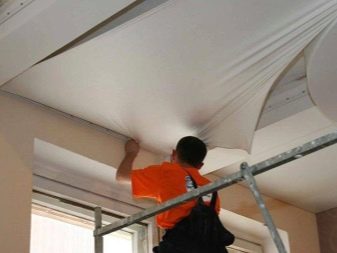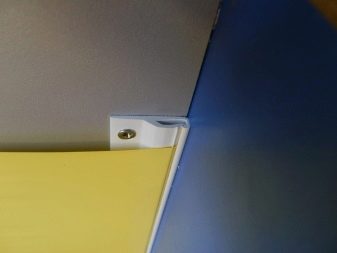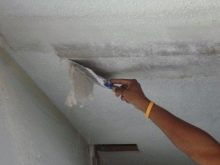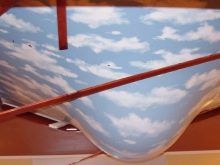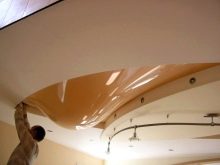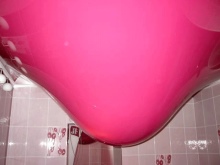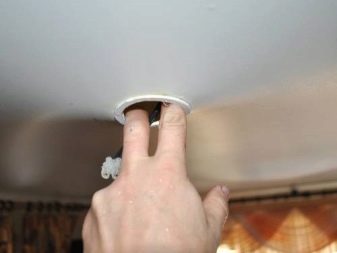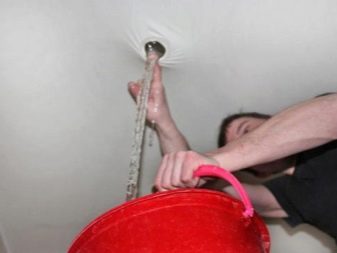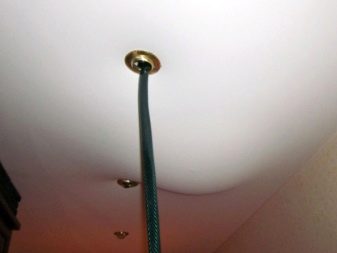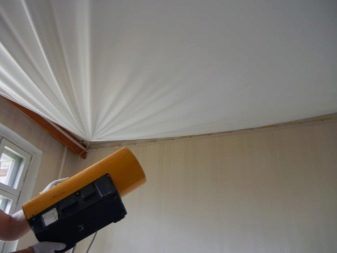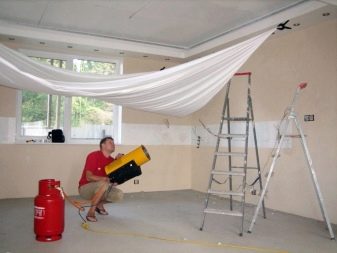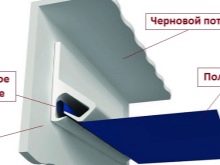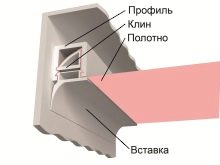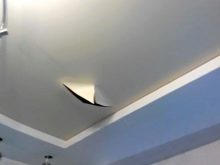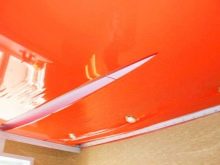Why does the suspended ceiling sag?
Stretch ceilings are made on the basis of film raw materials and high-strength vinyl. It differs in the small weight, a subtlety of a cloth, allows to execute any ideas on complexity. Despite the increased strength of the film, many face various problems after installing a new ceiling. One of them is sagging canvas.
Determine the causes
If the ceiling after installation sagged by 1%, this fact is not a defect. In this case, it should be remembered that it cannot be ideally even due to the impact on the web of its own weight. The greater the area of the room, the stronger the differences between the levels. If the area of the canvas is small, the tension will be less noticeable.
Initially, you need to thoroughly consider all theoretically possible problems that may arise after installing the ceiling.A competent approach to business will avoid costly installation, as well as save you time.
There are several major errors that most often occur during installation. Consider the main ones:
Incorrect installation
It is necessary to check how tight the baguette is against the wall. Perhaps the problem lies precisely in this. If the area of the ceiling zone is relatively small, a gap of 2 cm is enough to consider the ceiling sagging. Such a case may occur due to improper installation or use of inadequate wall fasteners.
Often, due to the negligent attitude of masters to the quality of work, dowels may not fit firmly in the loose foundation of the wall. The solution is to use longer dowels or search for a durable section of the wall.
The cause of sagging is often pieces of plaster falling from a fragile wall onto a stretch canvas. To solve the above problem, you need to contact the experts. Without dismantling in this situation can not do. To remove the plaster fragments, you need to remove part of the film or the entire canvas. In another way, this problem can not be solved.
Unstable Baguette Fastening
It is important to remember about the reinforcement of the frame of the structure at the level of fastening the baguette, if the installation of the ceiling is done to a plasterboard box. Stretch ceiling affects the plasterboard sheets, as a result of which the sheet may break or be partially torn off from the surface.
It is not necessary to mount the material on the base, which can cause damage.
Bad foundation preparation
Often, customers are faced with unfair preparation of the base. Stretch ceiling hides bumps, but this does not mean that the surface does not need to be cleaned from bumps and remnants of plaster.
In addition to leveling it is necessary to strengthen the surface with a primer. If this is not done, over time pieces of plaster will fall onto the canvas of the stretch ceiling.
Flooding
If you live in a multi-level house, the cause of sagging can be a banal water leak. Run your palm across the ceiling: if you feel heavy weight and rolling water at hand, the problem is leakage. Water can form a bump or a bubble. In this case, sagging ceiling visible to the naked eye.
Do not attempt to pierce the bubble, smooth it with improvised means, distill the water under the canvas in the direction of the hole for the lamp.
The size of the bubble depends on the density of the material.
You can try to solve the problem yourself. De-energize the living space. Remove the lamp and try to estimate the volume of fluid, looking inside the ceiling. Use a ladder or a stable support. If there is too much fluid, use a hose. Run one end of the hose under the canvas, lower the other end into the prepared container.
Self-draining does not guarantee the return of the ceiling to the original perfect look. (The exception is a fabric light-transmitting ceiling). You should not try to smooth out the folds. It will not be possible to cope on your own here: you will have to invite specialists. The correct solution is to heat the ceiling with a heat gun.which is used during initial installation.
Pressure drop and lack of tightness
If you live in a private house, the ceiling may sag, and after a while it becomes smooth. The reason for this is the pressure drop.The canvas can swell from a constant stream of air, which, for example, can come from an open window.
It must be remembered that air must not circulate between the main ceiling and the panel.
Temperature exposure
Most manufacturers claim that the stretch ceiling is not subject to deformation due to temperature changes. Unfortunately, this is not always the case. If the temperature in the room rises sharply, it can cause a rather serious deformation of the material. For example, it can stretch over the entire area, which will eventually require dismantling.
A noticeable drop in temperature has no significant effect. However, the constant low temperature can lead to compression and film and the appearance of cracks.
If there is a problem with lowering the ceiling, there are several ways out of an unpleasant situation.
Warranty case
The warranty works only when you have approached the choice of the contractor wisely. Reputable organizations must sign an agreement with you specifying all warranty cases of repair. Sagging of the ceiling is a fairly frequent occurrence, which the company should address at its own expense.. Such a way out of the situation with sagging stretch ceiling will be the most optimal.
If you have not signed an agreement with the organization before the start of construction, be prepared for the fact that the company may refuse warranty repairs. In this case, you will have to contact a third-party company or carry out the dismantling of the ceiling with his own hands. Please note that the dismantling procedure is rather complicated in execution, it is important to be confident in your abilities and to get rid of sagging extremely carefully.
Independent correction of defects
To solve the problem yourself, you need to understand exactly how the canvas is attached. Then you need to think about what kind of withdrawal you need: full or partial. Sometimes complete disassembly is optional, it is quite enough to use openings for lamps.
- Cam mount. In this case, use a special part - a movable cam. This is a self-clip that pulls and pulls the film. To disassemble the ceiling, you will need a spatula, which is used to press the moving cam and gently pull the canvas out from under it.
- Harpoon mount. In this type of fastening the canvas is edged around the perimeter.In this case, the ceiling is subject to minimal risk when attempting to dismantle. It will be easy to pull after fixing the problem.
- Wedge mount. The wedge is mounted in the groove of the baguette with a pre-slipped ceiling film. A plinth is mounted on top, which is used for interior decoration and reinforced wedge clamping. To disassemble the ceiling with this mount is quite easy.
The above types of fasteners are considered for cases of complete dismantling.
To eliminate small defects in the overlap, it is worth considering other methods:
- Notches. For small cuts (no more than 2 cm), you can use tape or glue. In this case, the main goal is to prevent the further spread of the defect. For large cuts using glass fiber, which are quite simple to use.
- Patch. You can use the patch. When applying it is necessary to use the material from which the film is made. This is done in order to avoid color contrast. If you want the patch to look neat, you need to put it on the back of the surface.Often a good solution is to install a light fixture on a damaged fragment.
- Stitch break It is one of the most unpleasant moments when sagging stretch ceiling. In such cases, despite the relatively small area of the defect, it is recommended to contact the company that installed the ceiling. Therefore, it is strongly recommended to approach the issue of choosing a company wisely, read reviews, listen to word of mouth about the quality of its coverage and the experience of the masters. The time spent searching for a really good organization will save you nerves and money.
An important role is played by the choice of proper care for your ceiling. You do not need much action. You will need a cleaning agent and a soft sponge. The detergent should be gentle, in any case do not use substances to clean the walls of the bathroom and ceramics (you risk scratching the surface).
Do not use brushes, as even the softest villi can tear a web. When rubbing the surface, do not press on the ceiling material.
Installation of suspended ceilings with their hands is complicated.Despite the constantly improving technologies and the quality of the materials produced, the installation of the ceiling requires careful and careful attitude. When self-installation always remains the danger of damage to the ceiling, cut film, uneven overlap (different in height). The professionalism of the specialists involved in the installation work is also important.
See below for an example of stretch ceiling repair.
